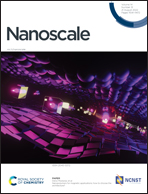Morphology and carrier mobility of high-B-content BxAl1−xN ternary alloys from an ab initio global search†
Abstract
The excellent properties of III-nitrides and their alloys have led to significant applications in optoelectronic devices. Boron, the lightest IIIA group element, makes it possible to extend the flexibility of III-nitride alloys. However, both BxAl1−xN and BxGa1−xN ternary alloys suffer from poor material quality during crystal growth, their B contents in experimental reports are no higher than 22%, and the underlying mechanism is still unclear. Herein, ab initio global calculation by particle swarm optimization combined with density functional theory is carried out to identify the ground structures of BxAl1−xN alloys with different B contents (x = 0.25, 0.5, and 0.75). Furthermore, the electronic properties and intrinsic carrier mobility are studied. For B0.25Al0.75N and B0.75Al0.25N, quasi-wurtzite and quasi-hexagonal structures are energetically favourable, respectively, indicating a wurtzite-to-hexagonal structural transition due to the three-coordinated B atoms being incorporated into the lattice. When the B content is 50%, B0.5Al0.5N shows a ten-membered ring structure with an indirect bandgap of 3.52 eV and strong anisotropy of mobility. Our results uncover the mechanism of the structural and electronic property evolution with B content and pave a route for the application of B-containing III-nitride alloys.



 Please wait while we load your content...
Please wait while we load your content...